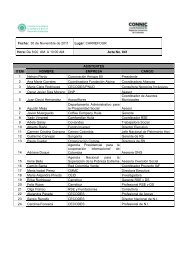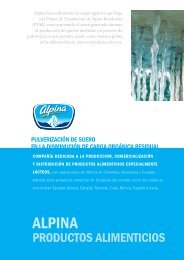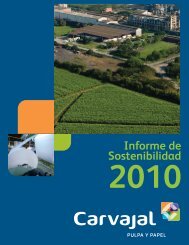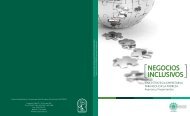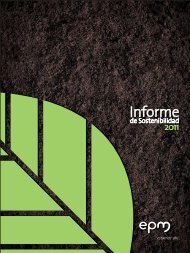Setting new standards - Friends Life
Setting new standards - Friends Life
Setting new standards - Friends Life
Create successful ePaper yourself
Turn your PDF publications into a flip-book with our unique Google optimized e-Paper software.
PARENT COMPANY ACCOUNTS<br />
ABBREVIATIONS AND DEFINITIONS<br />
Notes to the consolidated accounts continued<br />
1. Accounting policies continued<br />
A contract with DPF is a contractual right held by a policyholder to<br />
receive, as a supplement to guaranteed minimum payments,<br />
additional payments:<br />
• that are likely to be a significant portion of the total contractual<br />
payments, and<br />
• whose amount or timing is contractually at the discretion of the<br />
issuer and that are contractually based on:<br />
– the performance of a specified pool of contracts, or a specified<br />
type of contract, or<br />
– realised and/or unrealised investment returns on a specified pool<br />
of assets held by the issuer, or<br />
– the profit or loss of the company that issues the contracts.<br />
Investment contracts with DPF held within the FPLP and FPLA withprofits<br />
funds are measured on a basis that is consistent with a<br />
measurement basis for insurance contracts held within those funds.<br />
Balances representing eligible surplus that has not yet been<br />
allocated to shareholders, or policyholders with DPF contracts, are<br />
retained as a policyholders’ liability.<br />
1.3.20 Fund for future appropriations (FFA)<br />
The FFA comprises all funds available for allocation, either to<br />
policyholders or to shareholders, the allocation of which has not<br />
been determined at the balance sheet date.<br />
Within FPLP, the insurance and investment contracts liabilities allow<br />
for discretionary benefit allocations to the extent that they are<br />
allowed within current bonus practices. The FFA represents working<br />
capital and the value of future transfers to shareholders from the<br />
With-Profits Fund in respect of discretionary bonuses for<br />
conventional with-profits business.<br />
Within FPLA, the FFA represents the value of future final bonus<br />
payments to policyholders.<br />
1.3.21 Interest-bearing loans and borrowings<br />
Borrowings are recognised initially at fair value, which is generally<br />
the cash consideration received, net of transaction costs incurred,<br />
and subsequently stated at amortised cost. Any difference<br />
between the proceeds, net of transaction costs, and the<br />
redemption value is recognised in the income statement over the<br />
period of the borrowings, using the effective interest rate method.<br />
Convertible bonds that can be converted to share capital at the option<br />
of the holder, where the number of shares issued does not vary with<br />
changes in their fair value, are accounted for as compound financial<br />
instruments. Compound financial instruments are split and the equity<br />
and liability components recorded separately. The equity component<br />
of the convertible bonds is calculated on issue as the excess of the<br />
issue proceeds over the present value of the future interest and<br />
principal payments, discounted at the market rate of interest<br />
applicable to similar liabilities that do not have a conversion option.<br />
The equity component is recognised and included in shareholders’<br />
equity, net of tax effects. The fair value of the liability component is<br />
recorded on an amortised cost basis until extinguished on conversion<br />
or maturity of the bonds.<br />
The interest expense recognised in the income statement under<br />
finance costs, is calculated using the effective interest rate<br />
method. Interest accrued on variable rate interest bearing loans<br />
and borrowings is recognised under insurance payables, other<br />
payables and deferred income and not in the carrying value of<br />
interest bearing loans and borrowings.<br />
1.3.22 Provisions<br />
A provision is recognised when the Group has a present legal or<br />
constructive obligation, as a result of a past event, which is likely to<br />
result in an outflow of resources and where a reliable estimate of the<br />
amount of the obligation can be made. If the effect is material, the<br />
provision is determined by discounting the expected future cash<br />
flows at a pre-tax rate that reflects a current market assessment for<br />
the time value of money and, where appropriate, the risks specific to<br />
the liability.<br />
The Group recognises a provision for onerous contracts when the<br />
expected benefits to be derived from the contracts are less than the<br />
related unavoidable costs.<br />
1.3.23 Insurance payables, other payables and<br />
deferred income<br />
Insurance and other payables are recognised when due and<br />
measured on initial recognition at the fair value of the consideration<br />
paid. Subsequent to initial recognition, payables are measured at<br />
amortised cost using the effective interest rate method.<br />
Fees charged for services to be provided in future periods are deferred<br />
and recognised in the income statement on a straight-line basis as the<br />
services are provided over the expected term of the contract.<br />
1.3.24 Employee benefits<br />
(a) Pension obligations<br />
(i) Defined benefit schemes<br />
Pension schemes are in operation for employees of certain<br />
subsidiary undertakings. The principal schemes, to which the<br />
majority of employees belong, are of the funded defined benefit<br />
type with assets managed by F&C Asset Management plc (F&C), a<br />
subsidiary undertaking. The schemes provide benefits based on final<br />
pensionable salary. The assets of the schemes are held in separate<br />
trustee administered funds.<br />
The pension liability recognised in the balance sheet is the present<br />
obligation of the employer, which is the estimated present value of<br />
future benefits that employees have earned in return for their<br />
services in the current and prior years, less the value of the plan<br />
assets in the schemes. The discount rate applied to the employees’<br />
benefits is the appropriate AA rated corporate bond yield at the<br />
balance sheet date. A qualified actuary performs the calculation<br />
annually using the projected unit credit method.<br />
The pension costs for the schemes are charged to the income<br />
statement and consist of current service cost, past service cost,<br />
interest cost on scheme liabilities, the effect of any settlements and<br />
<strong>Friends</strong> Provident Annual Report & Accounts 2006 81








